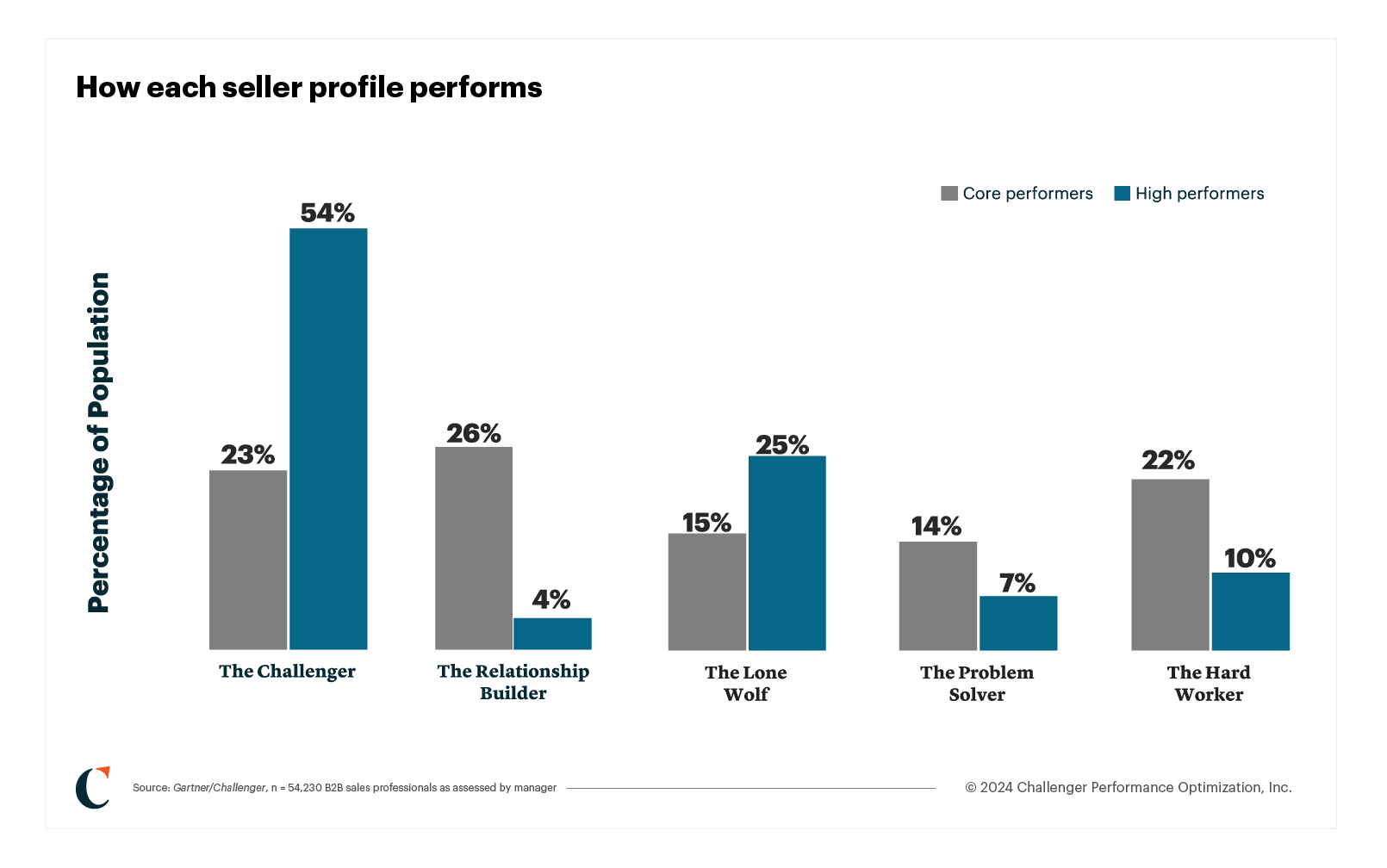Discover the Challenger Selling Profiles

Why do some sellers win while others fail?
If conventional (and by conventional, we mean LinkedInfluencer) wisdom is to be believed, it’s a matter of how early they wake up, how many hours they work, their cold-calling templates, and perhaps their persistence. Yet twice now, both in 2011 and again in 2020, our research showed something else: the most successful reps excel even in difficult economic environments by using a distinct set of skills.
The original Challenger research, performed by CEB (now Gartner), began as a study of customer loyalty. When researchers learned that the sales experience accounted for 53% of that loyalty, they naturally asked: what makes a great sales experience?
To answer this question, they began investigating the skills and competencies shared by all sellers. They asked managers to evaluate their sellers against each other on 44 attributes and skills, such as their goal orientation, business acumen, and ability to negotiate.
After sorting reps into the five profiles, the authors of “The Challenger Sale,” Matt Dixon and Brent Adamson, looked at how each performed. They asked participating companies to identify the top 20% of their sales force as measured by performance against goal.
The results revealed five clusters of behaviors, or profiles, of sellers. And the question of “who performed best — and worst?” yielded a shocking answer.
Get to the good stuff! What profile is most successful?
TL;DR:
- Core performers came from every category
- Of all the high performers in the study, nearly 54% fell into a single profile: the Challenger
- The least successful profile was the Relationship Builder (at just 7%).

The most significant number of high-performing sellers — 54% — identified as Challengers. These sellers employ four vital skills:
- Teach: They educate customers with Insights that disrupt a customers’ status quo and inspire them to view their business in a new light.
- Tailor: They deliver the right message to the right person at the right time, using their deep understanding of what drives a customer to action.
- Take Control: They discuss money, press customers on commitments, and use customer verifiers to move customers through their journey to purchase.
- Constructive Tension: They build constructive tension while teaching, tailoring, and taking control. They push their customers to think differently — even if they don’t immediately see eye-to-eye.
Keep Challenger fresh
Revisit Challenger concepts in a series of short clips. Explore these short, documentary-style videos featuring interviews with Challenger experts, author Matt Dixon, and more.
Diving into the five seller profiles
Yes, Challengers dominate the field when it comes to high performance. But they aren’t the only successful profile, and it’s undeniable that each profile brings something important to the table. So, let’s dive into the skills, strengths, and weaknesses of each individual profile – and how adding Challenger skills and behaviors to your toolkit can augment any dominant selling style.
Problem Solver sellers love to work out solutions that please customers (this is why you always lead team-building puzzles at SKO). You’re also among a rare group. When CEB (now Gartner) conducted the original Challenger research in 2010, the smallest number of sellers identified as Problem Solvers.
Strengths:
- You leave no stone unturned in your quest to explore every single option. After all, you want your buyers to feel good about their purchase.
- You love a checked box. You follow your prescribed sales process to a tee, rely on buyer verifiers, and never forget to submit your mileage reimbursement. You’ve been voted RevOps’ Favorite Person three years’ running.
- You run projects and administrative activities like a well-oiled machine, using tools like reminders, scheduled sends, and automated workflows to your advantage.
Only 7% of high-performing sellers and 14% of core performers identified as Problem Solvers. While your profile is still capable of high performance, it historically does not perform as well as others in complex sales.
Pitfalls:
- Your desire to solve problems doesn’t stop when the deal closes. While there’s nothing wrong with following a new customer’s performance, you can spend so much time following through that you don’t have enough time to drum up new business, leaving your pipeline empty.
- The thing about solving problems is that you’re always waiting for new ones to crop up. Problem Solvers find themselves most comfortable in a reactionary state of service.
- You hate discussing pricing and money in general.
The goal of following the Challenger methodology is not to “become” a Challenger but to learn ways to incorporate Challenger behaviors and mindsets into your personal selling style. Consider the following:
- Change the way you identify problems. Instead of servicing customers’ needs, consider spending time each week studying and learning about industry trends so you can approach them with solutions to problems they might not have even identified.
- Use your problem-solving skills. Once you know the customer’s hidden pain points, consider focusing on the ones only your business can solve (or can solve better than the competition).
- Keep a list of customer facts nearby to simplify your Tailoring efforts.
- Focus on the opportunity cost of failing to act. Prospect Theory tells us this is far more effective at driving action than potential gain. Then, role play with your manager. See more on opportunity cost in this clip from our on-demand Winning The Challenger Sale webinar.
As a Lone Wolf seller, self-doubt isn’t in your vocabulary (at least not when it comes to sales). You’re confident in your instincts—after all, they’ve brought you this far—and you’re usually right. If you’re hitting quota, why mess with what’s working?
Strengths
- When sharing your beliefs and opinions, you don’t hold back.
- At work, you’re extroverted, talkative, and unafraid to strike up conversations with strangers.
- You’re tenacious. Once a deal is in your jaws, you don’t let go.
- You’re a self-starter. There’s a fire inside driving you to meet your goals, and nothing will stop you from crushing them.
Being a Lone Wolf can also feel, well, lonely. About 18% of sellers identified by CEB (now Gartner) in the original Challenger research fell into this category. You frequently butt heads with your managers and sometimes your coworkers, too. Your performance speaks for itself, and you don’t see why you need to change your approach. We know that Lone Wolves don’t win as much as Challengers in complex sales. Lone Wolves comprised 25% of all high performers and 14% of all core performers.
Pitfalls
- You struggle to work with a team.
- Your manager wants you to follow processes such as pre-call planning checklists and tools and rehearse your pitch, but you consider those a waste of time.
- You don’t update your CRM. You know what works and prefer to rely on your instincts.
Look, we know the odds here – as a Lone Wolf, you possess a strong allergy toward coaching. But we know you love to win — and adding Challenger behaviors to your selling style can help you win even more in complex deals. Challengers make up 54% of high performers, making them the best-performing profile type.
The goal of following the Challenger methodology is not to “become” a Challenger but to learn ways to incorporate Challenger behaviors and mindsets into your personal selling style. Consider the following:
- Set time aside each week to learn about industry trends, focusing on identifying and delivering an Insight that reframes how your prospects think about their problems. Learn more about reframing your customer’s thinking in this clip from our on-demand Winning The Challenger Sale webinar.
- Lean into the tools that best complement your naturally effective selling style. Perhaps that’s AI support for buyer verifiers or a tool that helps you link your sales methodology to your Salesforce instance. Look for something to minimize your administrative and time burdens (and keep your manager in the loop). These can augment what works for you and improve communication.
- Find someone you trust and respect to rehearse your teaching pitch and stay on message. If coworkers aren’t an option, try a trusted friend, spouse, or your biggest professional rival.
- Practice validating your customer’s primary goals in your teaching pitch.
- Take Control of the sales process. Work with key stakeholders, apply appropriate pressure to customers, and tie agreed-upon steps to the next phase of your sales process. Read more about navigating growing buying groups.
For decades, we told sellers that building strong relationships was the only way to succeed. Think back: Perhaps your parents even made their careers by building solid relationships with lifelong customers. After all, it’s all about who you know, right? Around 21% of sellers fall into this category, which we call the Relationship Builder.
Strengths
- Customers ask for you by name, recommend you to their peers, and tell you they’ve loved working with you.
- You pride yourself on cultivating advocates among your coworkers and customers.
- People know they can come to you for answers; you’re never afraid to roll up your sleeves and help.
- Whether you’ve mentored a junior seller or joined a new professional group, you’ve experienced the benefits of a strong professional network.
We’d never argue that Relationship Builders stop nurturing those powerful connections. However, one of the most shocking findings from the research that inspired “The Challenger Sale” was how poorly this cohort performs in complex sales. Just 4% of all high performers are Relationship Builders, lower than any other profile.
Pitfalls
- Your natural tendency to maintain strong relationships with everyone may cause you to struggle when meeting your client’s business goals. Prioritizing your client requires you to deliver bad news, take control of the sale by going around a contact to reach different stakeholders, or employ Constructive Tension — which can cause personal friction.
- Similarly, Relationship Builders find it hard to exert the pressure customers sometimes need from a seller to move a deal forward.
- Never discuss money in polite conversation, right? Relationship Builders struggle to talk about pricing or say no to discounts.
So what can you do differently to improve your performance in complex sales? The goal of following the Challenger methodology is not to “become” a Challenger but to learn ways to incorporate Challenger behaviors and mindsets into your personal selling style. Consider the following:
- Remember that your goal is to develop a compelling Insight that disrupts your customer’s status quo. This requires you to zoom out and look at the problems their industry faces more broadly, while using your relationship building skills to unearth the specific ways your prospects are seeing and approaching (or not seeing and not approaching) those problems.
- Instead of waiting for customers to tell you about their problems, consider creating a more targeted approach to uncovering their objectives and needs. Write and keep handy a list of critical questions about a customer’s business, procurement process, and more that might lead to roadblocks later on.
- Leaping from a relationship-based approach to a Challenger mindset isn’t easy, and you may be hesitant to push back with customers. After you craft your teaching pitch around your customer’s business objectives, practice it with your manager and peers. The more you plan and practice, the easier it will be to take control and push forward, even when customers are unhappy. Here’s a tip to Reframe how you think about Constructive Tension from our on-demand Winning The Challenger Sale webinar.
- Never let a sales call end without agreeing on next steps for both you and your buyer and assigning to-dos. This is where that fantastic report you’ve built will come in handy. Customers know you’ll hold up your end of the bargain; practice ensuring they uphold theirs, too.
- Incorporate “trigger events” that may indicate blockers and sources of indecision into your workflow. AI-powered tools located in your call recording software (such as Gong’s built-in Challenger smart trackers) and seamlessly integrated CRM options (such as Challenger’s App in Salesforce) can help you catch these triggers and check the right boxes.
You’re a Hard Worker, and why wouldn’t you wear this label as a badge of honor? You proudly go the extra mile, you’re always willing to work extra hours, and you never give up. These characteristics defined your performance reviews and feedback ever since your first summer job, and chances are these skills extend to other areas of your life.
Strengths
- Empty pipeline? You would never. You hustle to generate new opportunities and stay on top of in-progress deals.
- Managers, customers, and co-workers recognize you for going above and beyond in every deal, regardless of size.
- You’re self-motivated and willing to do whatever it takes to find solutions that work for your prospects and customers.
Honestly, it’s easy to love Hard Workers. But as crushing as this is to hear, working harder doesn’t always pay off. About 21% of sellers identified by CEB (now Gartner) in the original Challenger research fell into this category, yet Hard Workers account for just 10% of all high performers.
Pitfalls
- Have you ever said, “My weakness is that I care too much”? That’s a great interview answer — and a risky approach to sales. Hard Workers often bog themselves down in details and struggle to find a strategic approach that elevates their pitch.
- Discussing pricing and money is challenging, especially since you’ve invested so much of your time in closing a deal.
We know you’re working hard – and that, as a Hard Worker, you don’t back down. That’s just one reason many Challenger trainers say Hard Workers are the easiest to coach into Challengers. The goal of following the Challenger methodology is not to “become” a Challenger but to learn ways to incorporate Challenger behaviors and mindsets into your personal selling style. Consider the following:
- Your passion for going the extra mile will really shine when you set it against developing a strong Insight. Add “learning about industry trends” to your weekly to-do list so you’re prepared to act as a trusted advisor in every client interaction. Then, go the extra mile: dig to find the unrecognized and underappreciated problem your customers must solve. This hard work will set you up to deliver a powerful Reframe that shifts the way they think about their business.
- Craft your teaching pitch around your customer’s business objectives, then practice it with your manager and peers. The more you plan and practice, the easier it will be to take control and push forward, even when customers are unhappy. Here’s a tip to Reframe how you think about pushing back, a tool we call Constructive Tension, from our on-demand Winning The Challenger Sale webinar.
- If it’s on your list, it will get done. Don’t ever let a sales call end without agreeing on your next steps and assigning to-dos, both to yourself and your customers.
- Incorporate “trigger events” that may indicate blockers and sources of indecision into your workflow. AI-powered tools located in your call recording software (such as Gong’s built-in Challenger smart trackers) and seamlessly integrated CRM options (such as Challenger’s App in Salesforce) can help you catch these triggers and check the right boxes so you can work smarter (instead of just harder).
Congratulations, you’re a Challenger seller! This selling style outperforms all others in complex B2B sales. The CEB (now Gartner) research that inspired “The Challenger Sale” found that 54% of high performers identified as Challengers.
Challengers stand out because you see sales differently. You approach each sales conversation with an understanding of your customer’s business and know how to build growth opportunities around specific Commercial Insights.
Succeeding as a Challenger also means being unafraid of ruffling feathers in the pursuit of solutions (we call that Constructive Tension). You’ve discovered that meeting your clients’ goals might mean pushing them outside their comfort zone, and that’s okay.
To continue growing as a Challenger, focus on honing the distinct skills Challengers leverage throughout successful sales: Teaching, Tailoring, Taking Control, all while using Constructive Tension.
Challengers also focus on consistently improving industry knowledge and financial acumen to deliver targeted insights and effectively Reframe a customer’s thinking.
Here are a few more resources to help you continue your Challenger journey.
Continue the conversation on our podcast
Wish you could hear from current sales and marketing leaders about how they put Challenger selling concepts into practice every day? There’s a podcast for that! On our Winning The Challenger Sale podcast, we dig deeper into the most pressing topics in sales and marketing through interviews with leaders, thinkers, and visionaries. Binge our 100+ episodes wherever you get your podcasts.
The bottom line:
No matter your selling style (or the selling styles you’re coaching), success is within reach. Many people misinterpret the goal of learning Challenger skills as an effort to “turn sellers into” Challengers. The goal of following the Challenger methodology is not to retrofit yourself into a Challenger but to learn ways to incorporate Challenger behaviors and mindsets into your personal selling style. We can all learn from the success Challengers experience while holding onto the best of what makes us uniquely successful.
Managers or leaders hoping to help sellers adopt more Challenger skills can explore our additional coaching resources. And if this article is the first step in your journey, know that we view sales as part of the ongoing customer experience rather than a goal to be achieved or a single transactional moment in time.
We’re pushing the vision of “The Challenger Sale” forward by exploring the latest developments in sales and marketing. Join us monthly for our interactive and entertaining webinar series, Winning The Challenger Sale or our 100+ episode podcast archive.
Join us there, and take the next step in your Challenger journey.










